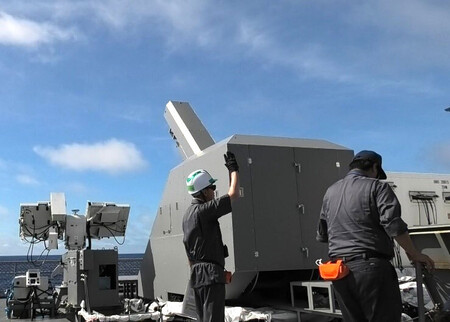Japan is going through one of the most crucial transformations in recent decades: its rearmament. It is its most aggressive defense policy since the Second World War, and the Ministry of Defense justifies it because we are in the “most severe and complex phase of the last 80 years.” And there is nothing that better exemplifies Japanese rearmament than a cannon that, until not long ago, was the stuff of science fiction.
The electromagnetic cannon.
Reconfiguration. Starting in the 1990s, Japan stopped investing significantly in its Self-Defense Forces. The bursting of the economic bubble, the “lost decade” and demographic difficulties meant that the military spending of 1% of GDP that was adopted after the 1947 Constitution was maintained. In 2023, things changed. As a result of the geopolitical complexity, they decided that they would invest 2% of their GDP in rearmament. In figures, we are talking about about 271 billion euros until 2027, but recently the objective has been brought forward to March 2026.
This reconfiguration will manifest itself in four dimensions: the aforementioned increase in military spending, the restructuring of the Self-Defense Forces, a relaxation of restrictions on the export of weapons and the expansion of long-range offensive capabilities. That’s where the railgun comes into play.
Electromagnetic cannon. Like gunpowder, it fires a projectile that gains speed as it passes through a barrel. However, it uses electricity instead of gunpowder. Two metal rails form a circuit that, when closed by the projectile, generates an intense magnetic field. This produces a beastly force that propels the projectile at high speed, allowing hypersonic, precise and long-range shots. This speed would allow it to travel without detouring even in the most unfavorable weather conditions.


Japan has been investing in this field since the mid-2010s, and a few weeks ago, Japan’s Acquisition, Technology and Logistics Agency (ATLA) conducted the first documented test firing of a naval electromagnetic cannon against a real ship. Mounted on the JS Asuka test ship, the prototype is a cannon of 40 millimeters in caliber and six meters in length.
It requires four huge energy containers to power the weapon and the projectiles used were small missiles of about 320 grams, stabilized by fins and without an explosive head. The explosion is not necessary: when reaching those 2,300 meters per second, the kinetic energy is comparable to that of a 1,000 kilo car colliding with something at 140 km/h.


Success. During them, the system achieved a record by firing projectiles at a speed of 2,300 meters per second. It is a speed of Mach 6-7, but in addition, they also pushed the useful life of the barrel to the limit. The estimate was about 120 shots, as it was established in previous phases of the investigation, but they managed to fire more than 200 shots without the system failing.
ATLA had conducted open sea tests before, but never against a real target. And although they had already commented that the tests were a success, now they have shared photographs in which you can see the holes left by these projectiles. The target ship was in motion, but due to the enormous speed and stability of the projectiles thanks to the enormous power of the system, the entry holes allow an almost perfect view of the “cross” left by the projectile passing through the hull.
Challenges. Now, understanding how a railgun works is easy, but executing it is extremely complex. It is a brutal technical challenge due to several factors:
- The stability of the barrel: the system generates tremendous heat, so dissipation systems must be effective enough not to compromise the integrity of the barrel. Wear and tear not only affects the speed and accuracy of the projectile, but can cause accidents on the boat itself.
- The energy: since it requires so much electricity to operate, it must have storage systems large enough to allow it to operate with the necessary power and during intense fire sessions.
- Miniaturization of the system: these cannons are extremely large and, although ATLA has managed to contain it quite a bit, mounting them on ships is not easy due to both the length of the cannon itself and the set of batteries required. Integrating a railgun into a ship is not easy.
Perspectives. Currently, ATLA is working on evolving a system that may not be as far from the action as was thought a few months ago, and that miniaturization would allow it to be mounted on other types of vehicles, in addition to ground defense lines. But apart from as a weapon, the agency has mentioned that the concept of electromagnetic acceleration could be applied to other areas.
For example, “mass launchers” that would allow materials to be launched electromagnetically in space transport. The problem is that other challenges are added, such as the imperative need to calculate the trajectory millimetrically or develop recovery methods for these goods.

USA and China. And, although it may seem like another test of weapons, what Japan has achieved is a milestone. After fifteen years of research and about $500 million invested in the technology, the United States abandoned the development of electromagnetic railguns in 2021 (although they are now with larger versions). Japan has persevered and its testing demonstrates that the system can be viable in a real-world context. And another that has continued to develop this technology is China.
They are keeping it more secret, but we have already seen images of Chinese ships with an electromagnetic cannon and energy containers on the front. And that, precisely, it is these two countries that are taking steps forward when it comes to developing this technology is no coincidence.
Both are engaged in the technological war, but also in an escalation of military tension that has been going on for months and that is leading both countries to accuse each other of invading their respective territory.
Images | ATLA, Japan Maritime Self-Defense Force
In WorldOfSoftware | Taiwan has had an idea if Beijing invades it: surprise China underground










